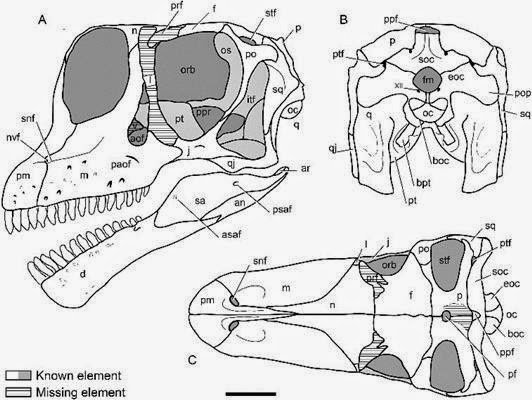
In a new study published in Journal of Systematic Palaeontology presents a detailed description of the skull bones of a dwarf sauropod, together with an updated reconstruction of an adult Europasaurus skull.
At 40 metres long and 100 tonnes in weight, and with an exceptionally long neck and small head, the herbivorous sauropod dinosaurs were the largest animals ever to have walked the Earth. In 2006, fossil remains of a diminutive form of sauropod – Europasaurus, measuring only 6 metres long and weighing just 0.8 tonnes – were discovered at a quarry in northern Germany. The fossils from the quarry are the best sauropod remains ever discovered, since they include most bones of the skull, as well as different growth stages.
In a new study published in Journal of Systematic Palaeontology, Martin Sander, Professor of Vertebrate Paleontology at the Steinmann-Institute of Geology, Mineralogy and Paleontology of the University of Bonn, and colleagues present a detailed description of the skull bones of this dwarf sauropod, together with an updated reconstruction of an adult Europasaurus skull.
In the Late Jurassic, 150 million years ago, Europe was an archipelago, and most reptile fossils from the continent are those of marine species. The few dinosaur remains that have been found would have been washed into the sea from the islands of the archipelago. Europasaurus would have lived on one of these islands, evolving as a dwarf island species.
Earlier analysis of backbone remains had suggested the existence of two different types (sizes) of Europasaurus. The current study, in its extensive analysis of the skull remains, confirms this dimorphism.
There are several hypotheses for the dimophism observed in the Europasaurus remains. The two types could be examples of male and female sauropods. Another possibility is that populations from two different islands have been preserved in the quarry. A third theory is that the quarry has preserved two populations that were separated in time by several thousand years.
The study contributes to an understanding of the evolutionary dwarfing of Europasaurus, which in turn sheds light on the unique gigantism of sauropod dinosaurs. The fossils will continue to yield important insights into sauropod dinosaur evolution and biology for years to come, and researchers hope that new fossils will continue to be found at the quarry for many years to come.
Journal Reference:
Jean Sebastian Marpmann, José Luis Carballido, P. Martin Sander, Nils Knötschke. Cranial anatomy of the Late Jurassic dwarf sauropodEuropasaurus holgeri(Dinosauria, Camarasauromorpha): ontogenetic changes and size dimorphism. Journal of Systematic Palaeontology, 2014; 1 DOI: 10.1080/14772019.2013.875074
Note : The above story is based on materials provided by Taylor & Francis.










